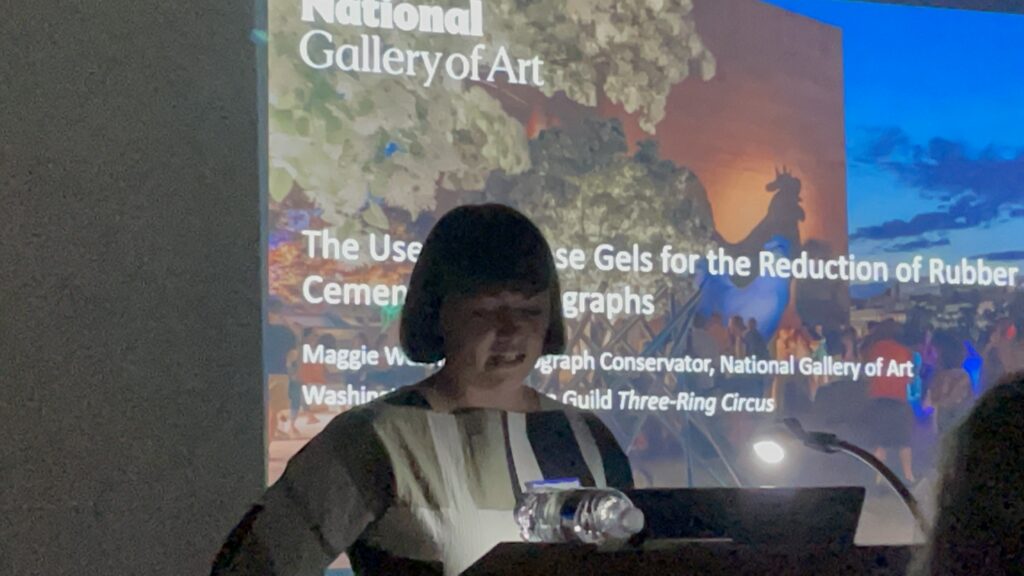Ring 1: WHAT’S OLD IS NEW
“The Use of Agarose Gel for the Reduction of Rubber Cement on Photographs”
Presented by Maggie Wessling, Photograph Conservator, National Gallery of Art
Summarized by Emily Mercer
On January 12th, 2023, the Washington Conservation Guild held its annual 3-Ring Circus at The Ripley Center. Ring 1, titled “What’s Old Is New,” included a presentation by Maggie Wessling on the use of agarose gels to reduce rubber cement adhesive on dye imbibition photographs at the National Gallery of Art.
The National Gallery of Art’s exhibition, The New Woman Behind the Camera, led to the acquisition of multiple dye imbibition (or dye transfer) prints by Caroline Whiting Fellows from the 1930s. Dye imbibition prints are three-layered structures that comprise a paper support, a baryta layer, and a top layer with dyes (the image material) in a gelatin binder. Wessling stated that the image is built up using the color separation technique with three dye sets. Most often cyan is set first, then magenta, followed by yellow on top. The dyes used to make these prints are often sensitive to water and solvents, creating treatment challenges.

Three Caroline Whiting Fellows dye imbibition prints were adhered overall to mounts with rubber cement and had become partially detached and distorted. Once the photographs were detached from the mounts, the photographs had remaining rubber cement adhesive on the verso which was determined to be soluble in acetone. The adhesive was manually reduced on two prints with cotton swabs soaked in acetone, which proved to be time consuming and strenuous. The third print had the thickest layer of remaining adhesive and therefore gels were taken into consideration. Tips from a recent gels workshop at an American Institute for Conservation (AIC) meeting led to the decision to use agarose gels due to their inertness.
Initially, 4% agarose in combination with weights caused cockling in the paper support. Treatment shifted to the use of 6% agarose gels, and they were placed on the verso of the print for approximately 20-minute intervals. Finally, Wessling cast and soaked a large sheet of gel which was placed on the verso overall. The use of the gels was effective in reducing a majority of the adhesive. Cockling created by the 4% gels was reduced by placing the print in a humidity chamber for a short period of time, followed by an extended period in a flattening stack. Humidification did not induce any bleeding of the image dyes.
Wessling provided tips for the use of gels which included microwaving the gel in a Pyrex container 10x the volume of gels, making various volumes of gels, and casting methods. She discussed creating a 2-to-4mm-thick template into which to pour the gel, placing a Mylar sheet over the gel, and then dragging a glass rod over the Mylar to create even thickness and size. She included tips on soaking the gels in solvent. Wessling suggested soaking them in acetone for 1 hour was sufficient and that the longer they soaked, the more brittle they became. She also went on to discuss their application. Good contact between the gel and the support impacted their effectiveness. Wessling suggests light weight such as putting a sheet of Mylar and Plexiglas on top of the gel is sufficient to ensure good contact.
The cons of using agarose gels was included in the presentation: The harvesting of agarose gel is not sustainable, but this negative impact may be offset by the ability to re-cast unused gel and store it in a refrigerator to be used at a later date. Wessling also warned that the gels cannot be rinsed of solvent and re-cooked after the addition of solvent.
Lastly, Wessling discussed the use of agarose gels to reduce aged adhesive on the recto of photographs with gelatin surfaces. A gel with an unknown concentration was soaked in an acetone/ethanol mixture for an hour and successfully reduced the yellowed adhesive sitting superficially on the gelatin surface. She warned that the condition of the gelatin is critical and may impact the whether the gelatin absorbs the solvent or the adhesive solubilizes and moves out into the photograph.